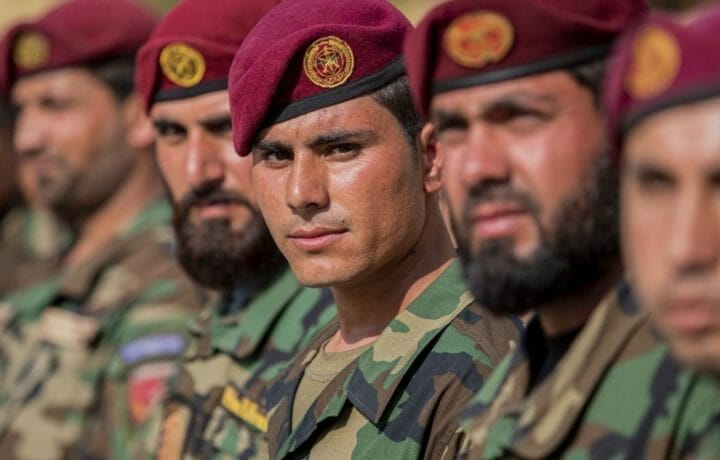I recently discussed the improvements within the U.S. Army and U.K. Military on the topic of soldier welfare with the Chief of General Army Staff, General Yasin Zia of Afghanistan. We discussed the efforts of U.S. Army Sergeant Major of the Army Michael Grinston in developing more open communication among leaders and their teams on difficult topics and morale issues in the fallout of the violent Fort Hood incidents. We also discussed the efforts of Senior Enlisted Advisor to the Chiefs of Staff Committee (SEAC) WO1 Glenn Haughton in opening a more direct and honest dialogue about mental health and suicide among the UK military.
He noted in our exchange that Afghanistan’s National Army had also been undertaking similar changes to improve the morale of soldiers, the capabilities of leaders, and ensure the families of military members feel supported and cared for, especially in cases of the loss of their family member in service. He said his team closely observes trends and advances in their security partners for new concepts.
Below are four areas that General Zia led his teams to address based on a thorough assessment of the Afghan National Army (ANA). This surge in improvement has been under way since July 2020.
1) Design and establish a direct and sustained line of communication between senior leaders and army personnel.
Personnel from across the levels of leadership can contact their chain of command directly and instantly via 24-hour active WhatsApp designated numbers to share information about realities on the ground, their needs, recommendations, and ideas. The Chief of General Army Staff said he understands the significance of hearing first-hand information from all personnel, especially those who serve in uniform in the most remote parts of Afghanistan, to ensure the security and interests of Afghans and our allies. Collecting, prioritizing, and responding to messages that are received via this direct line of communication from the personnel have contributed to ANA’s efforts to curb corruption, and increase coordination resulting in more effective operations.
2) Attend to the wounded and families of the martyred.
A military team has been created and assigned to attend to the wounded, martyred, and their families immediately after unfortunate events of the war. The Air Force provides immediate transportation to provincial capitals or Kabul whichever provides the closest medical facility for Afghan heroes who are wounded or martyred. After proper treatment in the case of wounded and proper procedures for the fallen, they are escorted to their homes. Prior to joining their families, the General Army Staff conducts a thorough analysis of the security threats to their families and in their communities and takes action immediately to curb such threats.
The General Army Staff also quickly provides the designated benefits in cash for the families of the martyred and the wounded, and then maintains regular and sustained contact with them. Just some examples of this teams’ efforts in the last eight months include:
- Providing food packages to over 1500 families of the martyred.
- Completing insurance paperwork for 60 personnel who had been stuck in the system.
- Resolving problems pertaining the salaries of 20 disabled heroes.
- Activating the pension of 77 disabled heroes.
- Sending 100 injured personnel abroad for treatment and coordinated with ICRC, many for artificial limbs.
- Providing food and responded to other needs of all those injured personnel who are not able to work in Kabul.
General Zia said that continuous treatment for the wounded and military families of the martyred will remain a top priority for the General Army Staff leadership.
3) Promote meritocracy.
The general staff conducted a thorough assessment of leaders, especially at battalion and brigade level, and the assessment was attended to by the Chief of General Army Staff. They assessed leaders based on characteristics such as commitment to country and service; leadership skills; command/combat capability; and ability to respond to emerging situations. All brigade commanders who failed to fulfill this criterion were dismissed or relocated and capable commanders were placed in these important posts over the past several months. The review of battalion commanders is close to completion. The review and assessment also included units on the battlefield, and it resulted in the replacement of corrupt or incapable commanders, with those who meet the highest standard of military leadership.
4) Boost morale and delegate initiative to the forces.
The first goal of the General Army Staff leadership team has been victory of the ANDSF on the battlefield and the defeat of the enemy. To help achieve this goal Chief of General Army Staff Zia personally appears among his fellow soldiers on the battlefield in all corners of Afghanistan. This strengthens the morale of the Afghan forces as the confusion stemming from the peace process swirls in the country. The General believes the boost in morale of the Afghan forces was a key factor in dismantling and defeating the enemy’s plans over the last 8 months. To strengthen morale, General Zia also identified, rewarded, and promoted many personnel who met specific leadership criteria and personally ensured they understood their freedoms to reinforce successful efforts and to avoid feeling they need to seek permission from Kabul to make local decisions to win battles. General Zia wants an innovative force that takes the initiative when opportunities reveal themselves.
General Zia and this team aim to expand on the solutions for these priority areas, identify gaps, and respond to the needs of the Army and the Army family as available resources will allow and in a timely manner.




